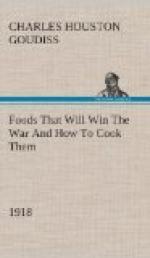A large saving in cooking fats can be made by the careful utilization of all fats that come into the home. Beef and mutton suet can be rendered and made available. Fats which have been saved after meals are cooked should be clarified—that is, freed from all objectionable odors, tastes or color—so as to be made available as shortening and frying fats.
The following recipes and suggestions make possible the use of all fats, and as fat shortage is one of the most serious of the world’s food problems, it is essential that every housekeeper have a larger knowledge of the utilization and economy of this essential food.
[Illustration]
TO RENDER FATS
TO RENDER FAT BY DIRECT METHOD
Run the fat through the household meat grinder or chop fine in the chopping bowl. Then heat in the double boiler until completely melted, finally straining through a rather thick cloth or two thicknesses of cheese cloth, wrung out in hot water. By this method there is no danger of scorching. Fats heated at a low temperature also keep better than those melted at higher temperature. After the fat is rendered, it should be slowly reheated to sterilize it and make sure it is free from moisture. The bits of tissue strained out, commonly known as cracklings, may be used for shortening purposes or may be added to cornmeal which is to be used as fried cornmeal mush.
TO RENDER FAT WITH MILK
To two pounds of fat (finely chopped if unrendered) add one-half pint of milk, preferably sour. Heat the mixture in a double boiler until thoroughly melted. Stir well and strain through a thick cloth or two thicknesses of cheese cloth wrung out in hot water. When cold the fat forms a hard, clean layer and any material adhering to the under side of the fat, may be scraped off. Sour milk being coagulated is preferable to sweet milk since the curd remains on the cloth through which the rendered mixture is strained and is thus more easily separated from the rendered fat which has acquired some of the milk flavor and butter fat.
TO RENDER FAT BY COLD WATER METHOD
Cut fat in small pieces. Cover with cold water. Heat slowly. Let cook until bubbling ceases. Press fat during heating so as to obtain all the oil possible. When boiling ceases strain through cheesecloth and let harden. If desired one-half teaspoon salt, one-eighth teaspoon pepper, 1 teaspoon onion and 1 teaspoon poultry seasoning may be added before straining.
TO RENDER STRONG FLAVORED FATS
To mutton, duck or goose fat add equal amount of beef suet or vegetable fat and render same as suet. This may then be used for shortening, or pan broiling for meat or fish dishes, and not have the characteristic taste of the stronger fats.




